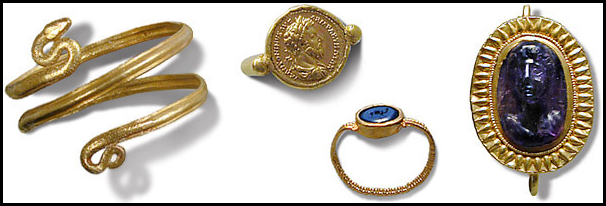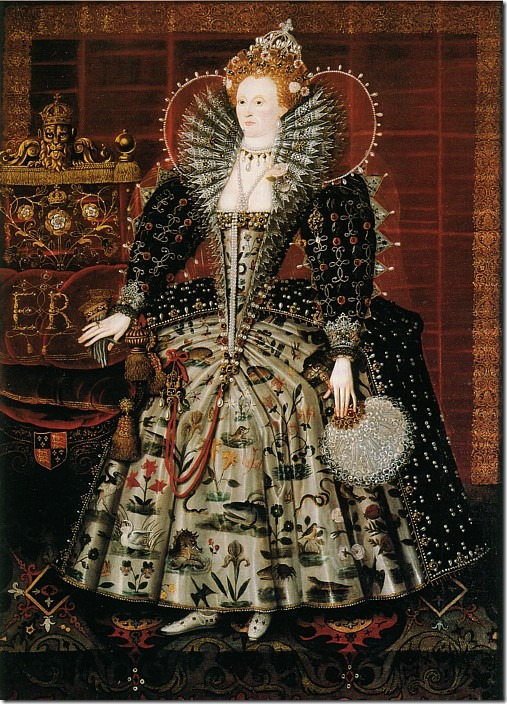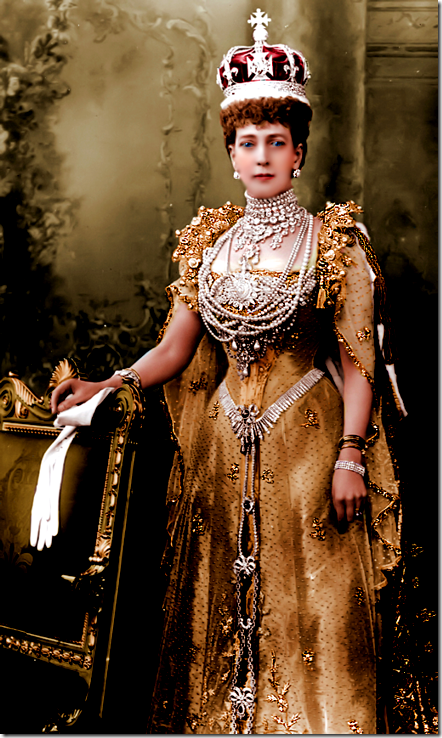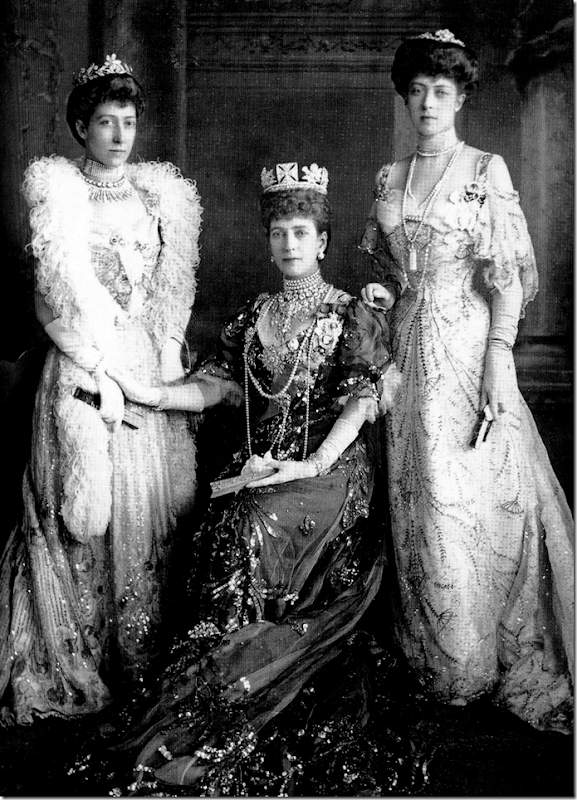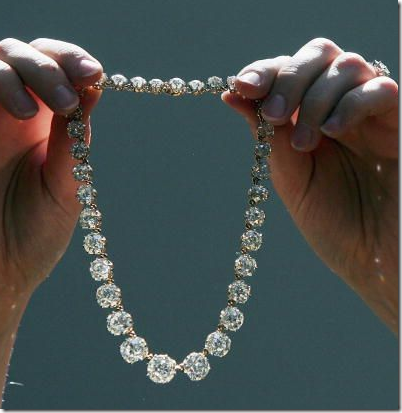This earring was found in Israel and was originally thought to be from the Byzantine period, around the 4th or 5th century A.D. After the earring was tested in the laboratory, it was discovered to be over 2,000 years old. Amazing. The piece is made out of gold and pearls and emeralds. For something that predates the Christian era, it looks amazingly fresh and trendy, even. I can imagine the jeweler Elizabeth Locke having a pair like these in her collection. If there were two of these, I would wear them to my nephew’s wedding this weekend.
These gold earring are from the 1st century, found in Afghanistan. My daughter recently gave me a pair a earrings that look remarkably similar.
17th century gold pendant – BC, that is! Amazing!!!! The pendant features bees circling the sun. But even at 17 century BC, it’s still not the oldest recorded jewel. That distinction belongs to the beads below:
This early string of beads, a total of 41 tiny shells, was found in a South African cave. There are visible holes and wear markings that document these shells were strung together. This necklace is more than 75,000 years old – 30,000 years older than any other ornament ever discovered. Even cavemen were vain, apparently.
A Short History of Jewelry:
Jewelry predates Homo Sapiens. The Cro-Magnon man who roamed the earth from 45,000-10,000 BC made jewelry adorned with engravings that told the story of their great migration from Africa to the Middle east, and on to Europe. Other early examples of jewelry are plentiful. In a Paleolithic cave in the Pyrenees mountain of France, an archaeologist found bracelets and necklaces made out of teeth, shells, mother of pearl and stone – strung with twine or a piece of animal sinew – that date from 17,800 to 6,500 BC. A Spanish cave produced the earliest example of gold jewelry – which also dates to the late Paleolithic period from 40,000 – 10,000 BC. Other metals such as copper, iron, tin, and silver were first seen over 10,000 years ago. Copper in jewelry was first used in 7,000 BC in Turkey. Metalworking was hard business though, until bronze came about in 3,500 BC, which in turn started the Bronze Age. Man really can only speculate what early jewelry was used for, as there is no written language from that age. Cave drawings from 10,000 to 12,000 are too basic to describe jewelry’s importance.
Gold bracelets found at the biblical town of Nimrud.
Many references to jewelry are found in the bible. Solomon's son paid a ransom in temple treasures and jewelry that belonged to the royal women. Jezebel was adorned with jewelry. Gold jewelry from Nimrud was discovered. Along with the Israelites, early Egyptians valued jewelry, especially that made of gold, which came from Africa. The early Greeks and Romans also wore jewelry. Greek jewelry was influenced from Asia after Alexander’s conquests. Roman women in particular wore large amounts of jewelry. The early Roman design, the fibula, which looks like a safety pin, is still produced today. Back then, the decorative fibula was used to pin clothing together. They were adorned with Sri Lankan sapphires and diamonds from India. Cameos and intaglio carvings were also popular with the early Romans, both of which are still popular styles today. Later in time, the Byzantine people used jewelry laden with gemstones. Men limited themselves to signet rings, similar to English men today. India was another country where jewelry was prevalent. Initially Indian jewelry was made of clay and shells, which was later replaced with glass and metals. India used their ornaments to ward off evil and pay dowries and slave beads were used as trading currency.
Early Roman jewelry: a snake bracelet and a coin ring that features emperor Marcus Aurelius (121 AD to 180 AD). Roman men were required to wear at least one ring, which was used with hot wax to seal documents and letters. The fibula, an early safety pin, held Roman clothes together. Here an intaglio is seen on the fibula’s front.
Queen Elizabeth I adored pearls, which were said to signify her virginity.
Coming out of the Dark Ages into the Renaissance, much jewelry of that age has been lost. The Thirty Years war caused great havoc on the civilized nations as all their natural resources were used to further their causes. Examples of jewelry from this time are almost non existent. After the war was over, France led the fashion movement and jewelry was changed completely with new designs. Old settings were melted down and reshaped to fit the trends. Gemstones became more important than the setting and the cutting of stones became an art. The Rose cut was most popular, but by 1640, stones with 16 surfaces started appearing. Amsterdam became the world’s stone cutting headquarters – as this is where the Portuguese Jews were expelled to. The design of the setting became more paramount: diamonds were set in silver and gem stones were set in gold. During this period, Baroque pearls fell out of favor while strings of pearls gained popularity. Enamel used in jewelry came primarily from Switzerland where only a few craftsmen could master the challenging art. One of the largest changes in jewelry came about in the 17th century. Before this time only royalty and upper class wore jewelry. But, in France, Italy and Holland, the country class were now able to afford to wear gold and silver ornamentation and it became part of their peasant costumes. This provincial jewelry rose in importance, while the upper class could only stand by and watch these societal changes.
The 18th century brought about Romanticism which had a huge impact on jewelry making. Modern archaeology revived an interest in ancient jewelry styles. The growing middle class’ desire for jewelry brought about the beginnings of costume jewelry and the development of paste and gem stone substitutes, something that today is still a huge portion of the market. At this time, goldsmiths flourished as the upper class required jewelry that was set apart from the costume varieties. This all changed when in America, Tiffany and Co. opened its doors in 1837 and Pierre Cartier opened their doors in France in 1884. Italy was the home of Bulgari. These jewelry stores signified the beginning of the mass production studios, which forever changed the individual craftsman’s dominance in jewelry making.
Queen Alexandra, Queen Elizabeth’s great grandmother, loved jewelry and she was only ever seen covered in pearls and diamonds.
The royal jewelry is never sold, it is simply passed down from generation to generation. Here, Queen Alexandra is seen in the pearls and diamonds that she passed down to her daughter in law, the future Queen Mary.
Queen Alexandra wearing a tiara which her great granddaughter, Queen Elizabeth has been wearing throughout her reign.
Queen Mary, Queen Elizabeth’s grandmother, wearing strands of diamonds she got from her mother in law.
Some of these same diamond strands were passed down to her granddaughter Princess Margaret. After her death, these diamonds were auctioned off, something that is rarely seen within the royal family.
And now, to the giveaway!!!!
The designer, Leslie Andrews, who creates all the jewelry for her company, Tarnished Lace, recently contacted me about a giveaway. Her jewelry appealed to me because she uses vintage pieces to make her unique, one of a kind pieces. Here is how she describes her work:
“I love bits and pieces of jewelry ephemera from previous centuries. I collect antique ivory, Venetian glass, crystal and mother of pearl beads, vintage rosaries, tarnished sterling charms and other tiny mementos to recreate necklaces, bracelets and earrings which evoke a sense of history. Additionally, I design and fashion heirloom pieces from clients' personal collections of family jewelry. This is my passion. Each item is unique and tells a story. The majority of components in each piece is a true antique (over 100 years old) or truly vintage (over 50 years old). My goal is to design beautiful, well-made, affordable jewelry which connects with the past.”
In picking out one piece of jewelry for the giveaway, we decided on the Victorian Eiffel Tower bracelet, as a tie in with the French theme of the blog. This piece is loaded with both vintage and antique treasures: the opalescent glass ovals and silver fleur de lis are circa 1940 and came from a necklace previously owned by a west coast opera singer. The Victorian filigree snowflake is circa 1900 and is encrusted with six clear rhinestones and a royal blue center stone. The link is from a post war souvenir bracelet from Paris and there is also a vintage sterling silver Madonna with a halo of tiny stars and sterling silver rose blossoms. All this on one bracelet! The winner of this giveaway will receive the Victorian Eiffel Tower bracelet, compliments of Tarnished Lace.
How to Enter:
Simply go to the Tarnished Lace web site here: http://tarnishedlace.com/gallery.html
Look at her items for sale and find one piece of jewelry that you really love and which speaks to you. Come back here to the comments section and leave a comment telling me your favorite piece of jewelry. That’s all! The contest will close this Saturday night at 12:00 pm.






